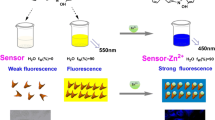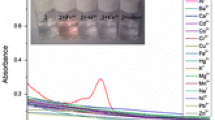Abstract
A new fluorescent probe RY was synthesized for the detection of Au3+ ions based on a rhodamine B derivative. The fluorescent probe showed good selectivity and sensitivity to Au3+ ions. Obvious color and fluorescence changes could be observed with the naked eye while the fluorescent probe reacted with the Au3+ ions. The detection limit of the probe was determined to be 36 ppb by the fluorescence titration; the excellent linear relationship suggests that the probe is potentially useful for quantitative detection of Au3+ in vitro. We also demonstrated its bioimaging application in both living cells and mice; this was the first time that a fluorescent probe was successfully applied to imaging Au3+ in living animals.
Similar content being viewed by others
References
Fierro-Gonzalez JC, Gates BC. Catalysis by gold dispersed on supports: the importance of cationic gold. Chem Soc Rev, 2008, 37: 2127–2134
Hashmi ASK, Rudolph M. Gold catalysis in total synthesis. Chem Soc Rev, 2008, 37: 1776–1775
Brown DH, Smith WE. The chemistry of the gold drugs used in the treatment of rheumatoid arthritis. Chem Soc Rev, 1980, 9: 217–240
Dreaden EC, Alkilany AM, Huang X, Murphy CJ, El-Sayed MA. The golden age: gold nanoparticles for biomedicine. Chem Soc Rev, 2012, 41: 2740–2779
Sperling RA, Gil PR, Zhang F, Zanella M, Parak WJ. Biological applications of gold nanoparticles. Chem Soc Rev, 2008, 37: 1745–2140
Boisselier E, Astruc D. Gold nanoparticles in nanomedicine: preparations, imaging, diagnostics, therapies and toxicity. Chem Soc Rev, 2009, 38: 1759–1782
Corma A, Garcia H. Supported gold nanoparticles as catalysts for organic reactions. Chem Soc Rev, 2008, 37: 2096–2126
Jans H, Huo Q. Gold nanoparticle-enabled biological and chemical detection and analysis. Chem Soc Rev, 2012, 41: 2849–2866
Habib A, Tabata M. Oxidative DNA damage induced by HEPES (2-[4-(2-hydroxyethyl)-1-piperazinyl]ethanesulfonic acid) buffer in the presence of Au(III). J Inorg Biochem, 2004, 98: 1696–1702
Nyarko E, Hara T, Grab DJ, Habib A, Kim Y, Nikolskaia O, Fukuma T, Tabata M. In vitro toxicity of palladium(II) and gold(III) porphyrins and their aqueous metal ion counterparts on Trypanosoma brucei brucei growth. Chem Biol Interact, 2004, 148: 19–25
Connor EE, Mwamuka J, Gole A, Murphy CJ, Wyatt MD. Gold nanoparticles are taken up by human cells but not cause acute cytotoxicity. Small, 2005, 1: 325–327
Seo H, Jun ME, Egorova OA, Lee KH, Kim KT, Ahn KH. A reaction-based sensing scheme for gold species: introduction of a (2-ethynyl)benzoate reactive moiety. Org Lett, 2012, 14: 5062–5065
Do JH, Kim HN, Yoon J, Kim JS, Kim HJ. A rationally designed fluorescence turn-on probe for the gold(III) ion. Org Lett, 2010, 12: 932–934
Wang JB, Wu QQ, Min YZ, Liu YZ, Song QH. A novel fluorescent probe for Au(III)/Au(I) ions based on an intramolecular hydroamination of a Bodipy derivative and its application to bioimaging. Chem Commun, 2012, 48: 744–746
Dong M, Wang YW, Peng Y. Highly selective ratiometric fluorescent sensing for Hg2+ and Au3+, respectively, in aqueous media. Org Lett, 2010, 12: 5310–5313
Yuan L, Lin WY, Yang YT, Song JZ. A fast-responsive fluorescent probe for detection of gold ions in water and synthetic products. Chem Commun, 2011, 47: 4703–4705
Yang XF, Guo XQ, Zhao YB. Development of a novel rhodamine-type fluorescent probe to determine peroxynitrite. Talanta, 2002, 57: 883–890
Li HL, Fan JL, Du JJ, Guo KX, Sun SG, Liu XJ, Peng XJ. A fluorescent and colorimetric probe specific for palladium detection. Chem Commun, 2010, 46: 1079–1081
Jou MJ, Chen XQ, Swamy KMK, Kim HN, Kim HJ, Lee SG, Yoon J. Highly selective fluorescent probe for Au3+ based on cyclization of propargylamide. Chem Commun, 2009: 7218–7220
Egorova OA, Seo H, Chatterjee A, Ahn KH. Reaction-based fluorescent sensing of Au(I)/Au(III) species: mechanistic implications on vinylgold intermediates. Org Lett, 2010, 12: 401–403
Author information
Authors and Affiliations
Corresponding author
Electronic supplementary material
Rights and permissions
About this article
Cite this article
Song, F., Ning, H., She, H. et al. A turn-on fluorescent probe for Au3+ based on rodamine derivative and its bioimaging application. Sci. China Chem. 57, 1043–1047 (2014). https://doi.org/10.1007/s11426-014-5107-x
Received:
Accepted:
Published:
Issue Date:
DOI: https://doi.org/10.1007/s11426-014-5107-x




